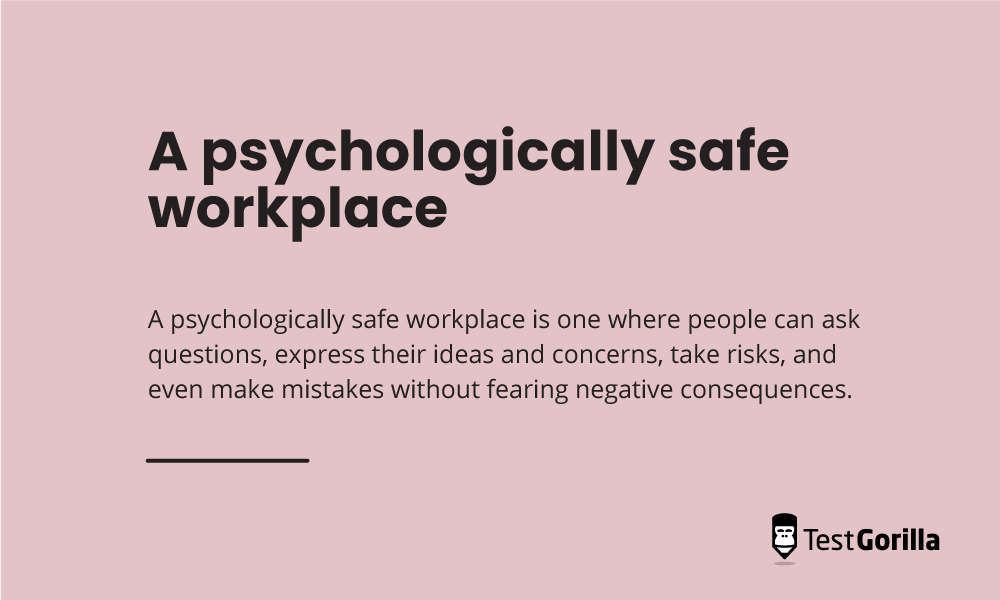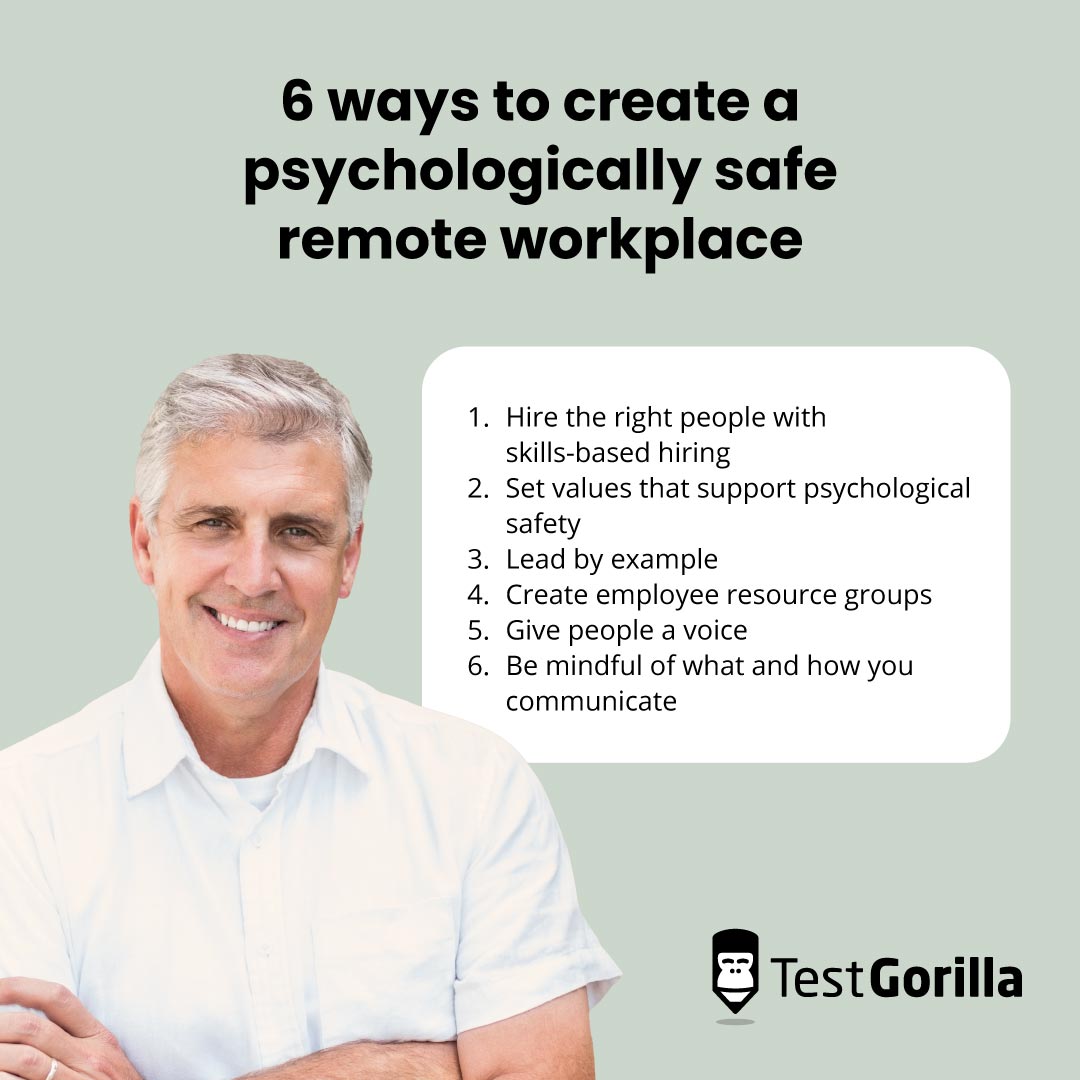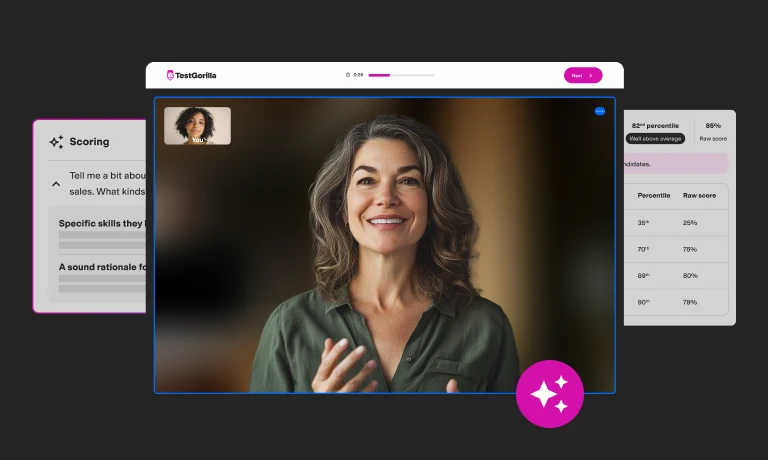The Covid-19 pandemic accelerated the shift to remote and hybrid work, giving organizations access to global talent pools. With that came the opportunity to build more diverse teams. When done well, this can transform your business performance, making for happier employees and higher retention rates.
The flip side is that working remotely has literally opened up a world of opportunities for candidates. This means that you need to rethink how you attract and retain talent. And there’s nothing more attractive than a psychologically safe environment where everyone – no matter who they are or where they’re from – feels comfortable and safe to be themselves.
This is especially important in remote teams where there’s a higher risk of your people feeling isolated and disconnected from their teams and their managers.
In this piece, we’ll walk you through the importance of psychological safety, the challenges for remote teams, and six strategies to help you create a safer, more inclusive remote work environment.
What is psychological safety and why should you care?
A psychologically safe workplace is one where people can ask questions, express their ideas and concerns, take risks, and even make mistakes without fearing negative consequences. In other words, a workplace where you can be yourself and speak up without fear of judgment, ridicule, or retaliation.
This is especially important in distributed teams that are made up of people from different cultures and walks of life.
The term psychological safety was coined by Harvard Business School professor Amy Edmondson. In her landmark TED talk she notes: “Every time we withhold [questions, concerns, and information,] we rob ourselves and our colleagues of small moments of learning. And we don’t innovate. We don’t come up with new ideas. We’re so busy managing impressions that we don’t contribute to creating a better organization.”
According to Dr. Edmondson, psychological safety encourages a culture of open communication and feedback. This leads to better decision-making and problem-solving, and more creativity and innovation.
Your people will also feel more engaged, motivated, and satisfied when they know their opinions and personal qualities are valued. This reduces stress, burnout, and turnover, which improves organizational performance and profitability while promoting an inclusive culture.[1]
Simply put, psychological safety is a must for building healthy and productive relationships, teams, and organizations. It creates a sense of belonging and empowers individuals to reach their full potential.
But creating a psychologically safe environment comes with some specific challenges for remote teams.
Let’s take a look at those.
The challenges for remote teams in creating a psychologically safe environment
Psychological safety is based on trust and relationships. But with distributed teams, there are fewer opportunities for face-to-face interaction. This can make it harder to establish connections and empathy between peers, or between teams and leadership.
When team members are spread across different time zones, there are fewer opportunities to have meaningful conversations and develop relationships. It gets especially complicated when the work pace picks up and people have less time to dedicate to anything but their tasks.
“One of the biggest hurdles… is building trust and connections with colleagues when you’re not in the same physical space. Without the ability to have informal chats in the break room or share a laugh over lunch, it can be hard to build the same levels of rapport and camaraderie that we might in a traditional office setting. The lack of face-to-face communication can also make it harder to gauge emotions and interpret nonverbal cues, leading to misunderstandings and miscommunications that can erode trust and psychological safety.…” – Natasha Maddock, the co-founder, and non-exec director of Events Made Simple.
In a physical office, you can detect when someone is struggling fairly easily, and provide the support and resources they need.
But in an online setting, it’s harder to read body language, tone of voice, and facial expressions to gauge how your people are feeling. These clues all tell you whether they’re doing well at work and feeling engaged or just trying to “get through it.” Do they have a healthy work-life balance or are they overworked? Can they trust and open up to a manager they’ve never met?
Finally, some people tend to hold back ideas, avoid asking questions, and shy away from giving tough feedback. Or they might have experienced trauma because of a lack of safety in previous workplaces, so they’re used to keeping to themselves.
When the majority don’t voice their concern, it makes it harder for other employees, existing or new, to break the silence. It’s a vicious cycle.
To address this, remote managers need to actively put more effort into promoting open communication than their in-person counterparts.
Consider this: years of social conditioning, conscious and unconscious bias, and harmful stereotyping often make it difficult for women and feminine-presenting people to speak up in the workplace and be heard. For women of color, this is even more challenging. In a remote environment, some women might find it harder to raise unpopular points, make important comments, and voice opinions during virtual meetings than their male counterparts.[2]
When it comes to hiring, it can also be more difficult to assess how well potential candidates will fit in with your teams when you can’t meet them face-to-face. This is a concern as mis-hires can cost anywhere between three to four times a position’s salary.
How can you create a culture of trust and hire the right people when you rarely – or never – meet in person?
Let’s take a look at some strategies to help you support your people.
The best insights on HR and recruitment, delivered to your inbox.
Biweekly updates. No spam. Unsubscribe any time.
6 ways to create a psychologically safe remote workplace
There’s no one-size-fits-all approach when it comes to creating a psychologically safe remote workplace. A lot will depend on the size of your organization, your working style, tech tools, and company culture.
That being said, we’ve put together six ideas to help you get started.
1. Hire the right people with skills-based hiring
Building psychological safety is a long-term undertaking that should be present in every aspect of your organization, starting with recruitment. One way to create a safer, more inclusive, and more diverse remote workplace is by using a data-backed, bias-free hiring method like skills-based hiring to find the right fit for your organization.
Competency-based recruitment involves hiring candidates based on quantifiable skills rather than subjective, bias-prone methods like resumes. Scientifically backed skills tests or work assignments are used to assess applicants’ skills before the interview stage.
For example, tests focus on the hard, soft, or transferable skills they need for the role, while assignments can replicate on-the-job scenarios. You can use pre-employment psychological testing to evaluate an applicant’s:
Aptitude and hard and soft skills
Strengths and areas for improvement
Behavior, values, personality traits, motivations, and interests
Culture add potential
This helps you reduce bias during hiring and recruit people who can positively contribute to creating a safe and inclusive remote work environment.
When hiring remotely, you have access to a wider talent pool. This means your applicants will be from different countries and from diverse cultures. Pre-employment testing gives you a standardized, objective set of competencies to look for, and helps you evaluate whether someone will thrive at your organization and make a positive contribution to your culture.
According to our 2022 State of Skills-Based Hiring Report, 91% of employers who used skills-based hiring observed an increase in workplace diversity. Additionally, 72.1% of people hired using this method are either happy or very happy in their roles.
When people trust you to notice their strengths and place them in the right roles, they’re more likely to be motivated, satisfied, and comfortable contributing ideas, opinions, and feedback.
Want to learn more about how skills-based hiring sets you apart from your competitors? Check out our guide to why skills-based hiring is key to winning the talent war.
2. Set values that support psychological safety
To create a psychologically safe remote work culture, you have to start by establishing your company’s core values. These principles are the foundation of your organization and guide your people’s decisions and behaviors. When team members align on shared ideals, they’re more likely to work toward creating a safer, more inclusive workplace.
Start by establishing values that contribute to building trust, fostering kindness and respect, encouraging open communication, and creating a sense of belonging – no matter where people are.
Here are some examples:
Always be kind and respectful: With distributed teams, people may work in different time zones and have different working and communication styles. That’s why it’s important to be mindful of everyone’s time, feelings, and bandwidth.
To put this into practice, discourage team members from working longer hours or logging on during the weekend. Encourage them to take breaks and ask for help when they’ve got lots on their plate.
Open communication: Encouraging and practicing open, transparent communication, creates an environment where people feel comfortable sharing ideas and concerns. This improves teamwork and boosts problem-solving.
While some information is obviously need-to-know, try to be as open as possible about what’s happening in the company – good or bad. This lets people know where they stand and what to expect, which builds the trust distributed teams need to function as a unit.
Radical candor: This means being truthful and empathetic when giving constructive criticism. When your people see feedback as an opportunity for growth rather than rebuke, you create a safe space where everyone can speak up.
For example, if one of your team members is consistently underperforming, let them know exactly where they’re falling short, what they can do to improve, and what resources and support are available to them. When it comes from a place of caring, honest, actionable feedback is much more useful to them than glossing over the problem because you’re trying to save their feelings.
3. Lead by example
As a leader, you should lead by example by embodying your company values. This shows people you take those values seriously. If you live the behaviors and qualities you expect from your people, they will too. So hold yourself as – or even more – accountable as everybody else.
For example, if radical candor is one of your company values, you can live it by leading with empathy when giving constructive criticism, always seeing the best in people, being open to receiving feedback, and never using the language of blame.
To apply this to a remote workplace, add anonymous feedback forms to your online workspace, motivate managers to provide virtual office hours for their teams, or conduct quarterly or yearly listening tours. That means jumping on quick video calls with people from different departments, and listening to their feedback about what is – and isn’t – working.
You can also promote healthy work-life boundaries by switching off from communication and collaboration apps, not checking messages after hours, and taking paid time off when you need it.
Finally, foster psychological safety by modeling vulnerability, listening actively, acknowledging your mistakes, and creating a culture of trust and respect. Your team members can also contribute by speaking up with any concerns or ideas, asking questions, offering suggestions, and supporting each other.
Authentic leaders practice self-awareness and are transparent, open, and honest with others…. When leaders demonstrate these behaviors and actions, they create an environment where their team feels safe to be their authentic selves, which is at the core of creating an inclusive culture.
Dr. Liz Wilson, founder of Include Inc.
4. Create employee resource groups
Employee resource groups (ERG) are voluntary, internal communities of workers with shared identities, interests, and experiences. These employee-led groups aim to foster a diverse, inclusive workplace and create a safe space for team members to discuss their ideas and concerns.
They create a sense of community and belonging that helps people feel supported and validated in their experiences. This can lead to higher job satisfaction, better well-being, and improved levels of engagement. They’re also focused on making your people feel more connected, which is really important for distributed teams who may feel isolated.
Some of your people might not feel comfortable opening up over a Zoom call to managers they’ve never met. But they’re more likely to bring up any issues with their fellow employees in a group that can then keep leaders in the loop.
To make this happen for your remote teams, create dedicated ERG channels in your communication apps, and encourage them to hold weekly check-in huddles using a virtual meeting tool.
Finally, many ERGs educate and raise awareness around issues related to diversity, equality, and inclusion (DE&I) within their organizations. This helps create a more inclusive workplace culture that values diversity and promotes understanding and respect for all employees. In a remote team, this can take the form of organizing virtual events, webinars, and even courses.
ERGs can also drive change by advocating for policies and practices that support DE&I. This can include everything from recruitment and retention strategies to training and development programs that create a more inclusive and equitable workplace.
ERGs play a big role in creating a psychologically safe remote work environment, which is why they’re becoming increasingly common in workplaces across the world. In fact, they exist in 90% of Fortune 500 companies.
5. Give people a voice
When your people are scattered around the globe, messages can fall through the cracks sometimes. As a remote manager, you need to purposefully encourage open, transparent communication and active listening. This lets you spot warning signs earlier, discover innovative ideas, and let your people know their feedback is valued.
One way to amplify your team members’ voices is to proactively solicit feedback on a regular basis. You can do this through online surveys, focus groups, or 1:1 conversations.
“Communication can be a tough nut to crack when working remotely, but it’s vital to have the right tools and methods to stay connected with the team. I’ve learned from my own experiences that active listening and regular feedback sessions can do a lot to build a sense of community. Being transparent about the challenges we face and really taking time to consider the needs of everyone on the team is [also] important.” – Kimberley Tyler-Smith, vice president of strategy and growth at Resume Worded.
But you need to do more than listen. Your people need to know that you take their feedback seriously, consider it when making decisions, and act on it. If you can’t act on their feedback in the short term, tell them why. Honesty goes a long way.
Remember: For your remote workers to use their voice and connect with others, they need the right software and tools. Use tools that help your people communicate async, like Loom videos or email, or in real time, like Google Meet or Microsoft Teams.
When deciding on your tools of choice, think about the features your people will need to talk to each other better – and which ensure everyone can be heard. For example, hand raising in virtual meetings, anonymous polls, and dedicated Slack channels for “watercooler” conversations.
6. Be mindful of what and how you communicate
In remote environments, a lot of verbal and nonverbal communication cues can get lost or are misinterpreted. For example, if someone’s had a bad night’s sleep and communicates in a more “dry” way than usual in written communication, their remote coworker might interpret that as them being “rude” or “upset.”
In a physical environment, spotting the signs that your colleague is just tired, rather than upset with you, is easier than it is online.
Sixty-two percent (62%) of remote office workers say these misinterpretations negatively affect their mental health. Ninety-seven percent (97%) of people felt the need to add something extra in digital communication to clarify their tone.[3]
This means you need to always think about how you convey your messages. A remote environment with constant miscommunications erodes trust and discourages people from speaking out.
To build trust, promote collaboration, and foster a sense of belonging between your remote team members, you should also think about the communication channels you use. Different channels are appropriate for different types of interactions. For example, email is good for formal communication; instant messaging wins for quick questions or updates – but things can get lost if they can’t be acted on immediately; and a quick video call or huddle is always best if there’s a chance you could be misinterpreted.
Pro tip: Create more opportunities for your people to connect and get to know each other beyond essential work interactions. There’s less chance of misunderstandings when team members know others well and are familiar with how they communicate.
You can do this by organizing virtual team-building events, adding icebreakers or games to your online team meetings, and scheduling cross-departmental virtual coffee meetings regularly.
The key to creating inclusive, psychologically safe distributed teams
Psychological safety is the idea that your people can ask questions, speak up with concerns, take risks, and even make mistakes without fearing negative consequences. It’s the ability to freely be themselves and bring their unique abilities, skills, and qualities to the workplace.
Without it, individuals can feel uncomfortable or even unsafe sharing their thoughts and ideas, which limits creativity, communication, and collaboration.
Creating psychological safety is essential for innovative, high-performing, and happy teams. This is especially important in remote teams that may lack the support structure and regular contact of traditional, in-person workplaces. Distributed teams that feel heard, valued, and connected to their managers and team members are more likely to trust them and work well together.
This is why you need to be intentional about creating psychological safety for your remote teams.
Our six best practices for creating psychological safety remotely include:
Hiring the right people with skills-based hiring
Setting values that support psychological safety
Leading by example
Creating employee resource groups
Giving your people a voice
Being mindful of what and how you communicate
When you implement these best practices, you’ll be well on the way to creating a great remote work culture where people feel seen, heard, and engaged.
Skill-based hiring puts the right people in the right jobs – wherever they are. Discover how skills-based hiring helps you build a diverse, inclusive, and positive remote workplace. Download the 2022 State of Skills-Based Hiring Report.
Sources
“Guide: Understand team effectiveness.” Google. Accessed March 2, 2023. https://rework.withgoogle.com/print/guides/5721312655835136/
“Women Face a Double Disadvantage in the Hybrid Workplace.” Harvard Business Review. Accessed March 2, 2023. https://hbr.org/2022/03/women-face-a-double-disadvantage-in-the-hybrid-workplace#:~:text=Women%20sometimes%20find%20it%20harder,workplaces%20feel%20less%20psychologically%20safe
3 Ways Employers Can Use Technology to Overcome Barriers at Remote, Hybrid, or Asynchronous Workplaces.” Loom. Accessed March 2, 2023. https://info.loom.com/hubfs/PDF%20Assets/Using%20technology%20to%20overcome%20workplace%20barriers.pdf
You've scrolled this far
Why not try TestGorilla for free, and see what happens when you put skills first.





















